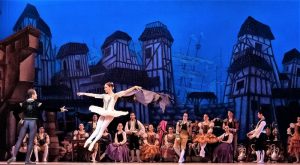Scenography
The term scenography covers all the elements that contribute to establishing the atmosphere and climate of a staging such as light, sound, decoration or clothing. It is important to point out that scenography does not only allude to the theatrical field. Cinema and television also have scenographies. In this sense, scenography is the art that ensures the success of many events, whether they are plays, films, concerts, programs or even conferences or seminars. It is therefore a very valuable discipline for preparing the stage decoration.
What is scenography?
Scenography, as its name indicates, is a discipline that allows us to present a scenic decoration. It is a group of plastic and pictorial elements harmoniously conjugated in order to organize the scenic space of a theatrical work or any other type of spectacle. To do this, it is important to consider the message you want to convey to the public.
Scenography characteristics
In general, there is no single stage space established because all spaces can be modified and adapted to the idea that a set designer has conceived for it.
It could be said that it is important to make a space come to life in such a way that it can define a significant view of the world. It is also important that the scenography highlights a reflection on the division of space, time and action. A poetic value must be given to the scenic space, taking into account what one wishes to represent.
History
Etymologically, the word scenography comes from the Greek skênographia, which alludes to the art of decorating the skênê, which later would enclose the Greek theatre space. The Greeks even created an object capable of changing the decorations according to the different scenes, which they called periact.
Scenography has evolved from its historical roots in classical antiquity and its links with Renaissance architects, thanks for the most part to theatrical activity in Eastern Europe in the 20th century.
This is how in the mid-twentieth century, scenography emerged as a dynamic staging of theatrical space that differs from static and routine decoration. The scenographers thus invoke a space dramaturgy, a spatial writing motivated by the revolution in the plastic arts, lights, cinematographic projections, etc.
Scenography components
Scenography is formed by the visual elements that constitute the scenic representation. Some of these elements are mentioned below:
- Lighting: This is a fundamental element, especially when the scene is developed in an interior space. For example, a dark lighting can recreate a gloomy atmosphere. Likewise, through a focused light, a particular element of the scene can be highlighted.
- Wardrobe: This element provides information about the characters of the scenic representation.
- Makeup: It is necessary to give the actor the appearance required for his role. The makeup can also include other elements such as wigs, beards, noses, among others.
- Backstage: They constitute the scenography space support when the scene is developed in a theater.
Types of scenography
According to its characteristics, the scenography can be classified as follows:
- Abstract: This is a scenography that does not focus on a particular place or time. In this case, the scenography does not pretend to represent reality, but is composed of plastic elements. (shapes, colors, volumes).
- Realistic: In this case, the decoration represents a place that seems real. It can be a faithful copy of a particular place or associate different elements that suggest that place.
- Suggestive: Also known as “non-Japanese theatre“. In this case, the scene is wide and is endowed with a kind of lateral corridor (bridge) that allows actors to make their entrance while the stage is usually in the center. The audience is closer to the stage and distributed around it.
- Functional: This is the type of scenography less frequent in dramatic representations since only the exact elements necessary for the scenic representation are used. It is generally used in circuses. In fact, this type of show only uses the necessary resources such as ropes, balls, among others.
Importance
Although some people are unaware of it, scenography is an essential part of our lives. It encompasses both decoration and architecture. Whether for dramatic, lyrical or choreographic staging, scenography occupies a prominent place as it embellishes the context of an event and enhances the message you want to send to the viewer.
How to cite this article?
Briceño V., Gabriela. (2019). Scenography. Recovered on 4 January, 2025, de Euston96: https://www.euston96.com/en/scenography/










